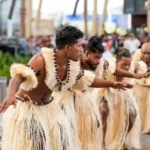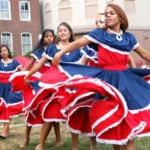Nauru traditional dress: A Glimpse into Cultural Identity
Nauru, a small island nation in the Pacific Ocean, is renowned for its rich cultural traditions, including its unique approach to clothing. While modern fashion has largely replaced traditional attire in everyday life, Nauruan traditional clothing continues to play an essential role in ceremonies and cultural preservation.
This article delves into the history, styles, and cultural significance of traditional clothing in Nauru, offering insights into this island’s vibrant heritage.
Historical Overview of Nauruan Traditional Attire
Historically, traditional clothing in Nauru was simple and practical, reflecting the tropical climate and the resources available on the island. Early garments were crafted using locally sourced materials such as pandanus leaves, coconut fibers, and bark cloth. These natural materials were woven or processed to create functional yet decorative pieces of attire.
Nauruans used clothing not only for protection from the elements but also as a medium for expressing social identity, status, and connection to their cultural roots. Traditional garments were often adorned with intricate patterns, symbolizing familial ties or clan affiliations.
See also Traditional clothing in Marshall Islands
Traditional clothing in Marshall Islands
Key Elements of Traditional Clothing
👔 Men’s Attire
- Loincloths (Ridi): The primary traditional garment for men was the ridi, a loincloth made from bark cloth or woven fibers. It was lightweight and ideal for the island’s warm climate.
- Decorative Accessories: Men often accessorized with armlets, headbands, or necklaces made from shells, feathers, or bones, symbolizing their rank or role within the community.
👗 Women’s Attire
- Grass Skirts (Tibaua): Women traditionally wore skirts crafted from finely woven pandanus leaves or grasses. These skirts were dyed in vibrant colors using natural pigments and sometimes layered for special occasions.
- Upper Garments: While women often left the upper body uncovered in daily life, ceremonial attire included colorful shawls or wraps made from bark cloth.
🌺 Adornments for Both Genders
- Shell Jewelry: Shell necklaces, bracelets, and earrings were common adornments, showcasing the island’s connection to the sea.
- Headgear: Intricately woven headbands or floral crowns were worn during festivities and ceremonial events, emphasizing Nauruans’ creativity and artistry.
Regional Variations in Traditional Clothing
Although Nauru is a small island, its traditional clothing exhibits subtle variations influenced by clan traditions and regional practices:
- Northern Region: Brightly dyed skirts and intricate shell jewelry are more prominent, reflecting the clans’ preference for bold visual statements.
- Southern Region: Simpler designs and natural tones dominate, emphasizing connection to the land and sea.
Traditional Clothing in Ceremonial Contexts
Traditional attire in Nauru is most visible during cultural ceremonies, festivals, and community gatherings. These occasions allow Nauruans to reconnect with their heritage and showcase their craftsmanship:
- Menen Festival: During this annual event, participants wear traditional clothing to perform dances and songs, celebrating the island’s history and resilience.
- Weddings and Birth Ceremonies: Special garments and adornments are crafted for these milestones, often incorporating symbolic designs and family heirlooms.
Modern Influence and Preservation Efforts
Today, traditional clothing in Nauru is rarely worn in daily life, as Western-style clothing has become the norm. However, efforts to preserve Nauru’s cultural heritage ensure that traditional attire remains an integral part of the island’s identity:
- Cultural Workshops: Local artisans teach weaving and dyeing techniques to younger generations, passing down the skills needed to create traditional garments.
- Tourism Initiatives: Showcasing traditional clothing during cultural tours and events helps promote Nauru’s heritage to visitors and raises awareness of its unique identity.
- Community Celebrations: Festivals and public performances continue to provide a platform for traditional clothing to shine, reinforcing its importance in Nauruan culture.
The Significance of Traditional Clothing in Nauru
Traditional clothing in Nauru is more than a representation of the past; it’s a living testament to the island’s cultural richness and resilience. By preserving and celebrating these garments, Nauruans honor their ancestors and ensure that their unique traditions endure for generations to come.
See also Traditional Clothing in Puerto Rico: A Vibrant Blend of Taino, Spanish, and African Heritage
Traditional Clothing in Puerto Rico: A Vibrant Blend of Taino, Spanish, and African Heritage
From the practical loincloths and grass skirts of history to the vibrant ceremonial attire of today, Nauru’s traditional clothing offers a window into the heart of its culture, weaving together threads of identity, artistry, and pride.